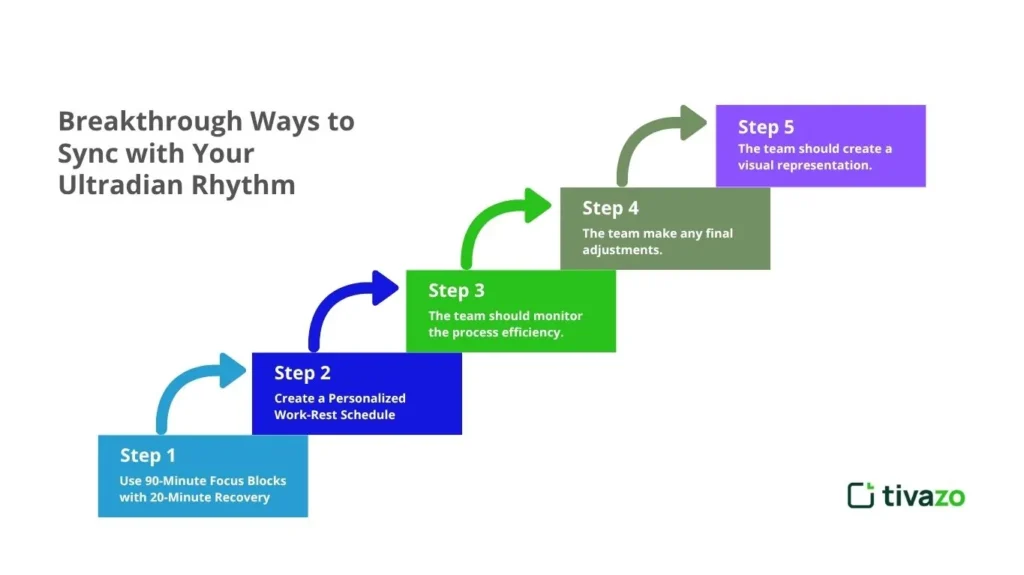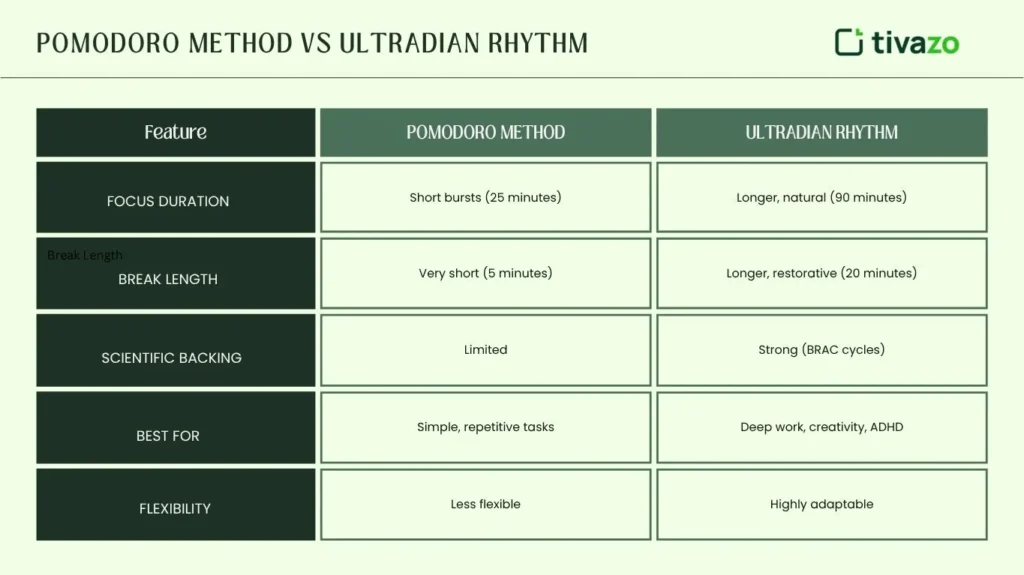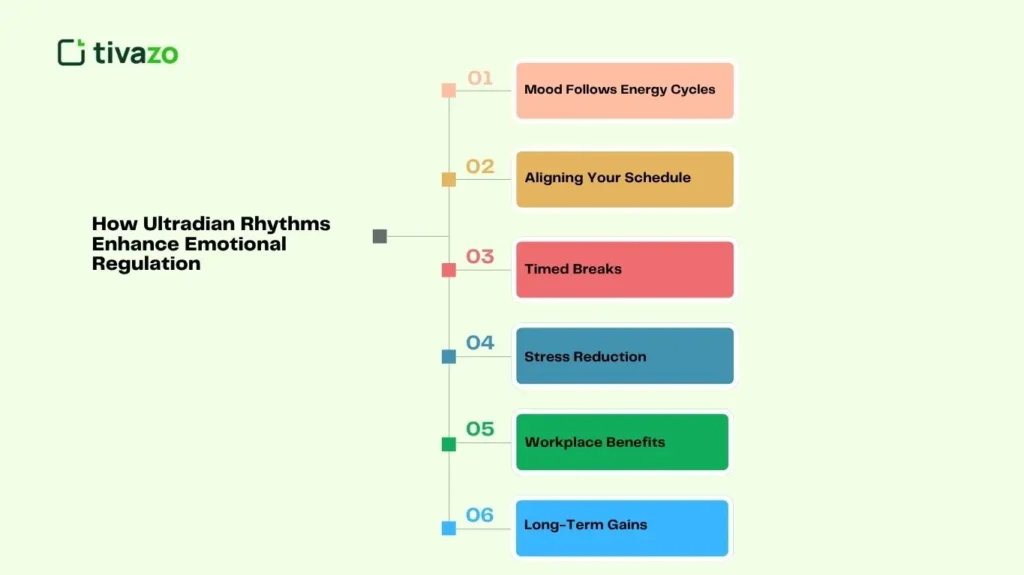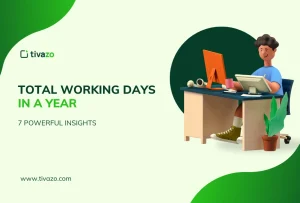Do you ever find yourself drained halfway through your workday, despite a full night’s sleep? Science says it’s not just your to-do list it’s your ultradian rhythm. In short, your brain’s energy, creativity, and attention levels are powering your ability to focus in cycles of 90–120 minute ultradian focus cycles. Most people fight their natural ultradian rhythms.
But the most productive students, professionals, and entrepreneurs ride their natural rhythms. In this blog, I will show you exactly how to be in sync with your ultradian rhythm using these five powerful methods. Whether you have ADHD, a demanding job, or you just want to be smarter in the way you work, this guide will give you your edge. To power your productivity through your biology, not burnout.
Key Highlights:
- What Is Ultradian Rhythm
- How the 90-Minute Brain Cycle Works
- Breakthrough Ways to Sync with Your Ultradian Rhythm
- Pomodoro Method vs Ultradian Rhythm
- How Ultradian Rhythms Enhance Emotional Regulation
What Is Ultradian Rhythm?
Ultradian rhythms are biological rhythms that repeat multiple times per day, typically every 90 to 120 minutes. There are spikes in your brain where you may be very focused, which is followed by a natural drop in energy that suggests taking a break. After around 90 minutes of work, your brain will naturally prompt you to take a break; this period of lower cognitive performance is your ultradian low.
Unlike circadian rhythms that feature a 24-hour cycle, ultradian rhythms feature multiple resets over the course of a day, and these rhythms can impact effective productivity, mental clarity, and stress. Working within your ultradian rhythm is essential to optimal cognitive performance.
How the 90-Minute Brain Cycle Works
The Basic Rest-Activity Cycle (BRAC) is a scientifically validated brain form of energy discovered by sleep researcher Nathaniel Kleitman. Your brain will go through 90–120 minute ultradian cycles of high focus boost, supported by recovery dips.
When we don’t work with this rhythm, and push through brain fatigue, or fail to take breaks, we are likely to experience:
- Loss of mental clarity
- Fewer creativity and problem-solving skills
- Greater stress and risk of feeling burned out
On the other hand, working with ultradian rhythms allows for:
- Peak energy over sustained periods
- Focused energy and motivational skill
- Balanced work and family life through natural breaks
5 Breakthrough Ways to Sync with Your Ultradian Rhythm
5 Breakthrough Ways to Sync with Ultradian Rhythm are:

1. Use 90-Minute Focus Blocks with 20-Minute Recovery
The best way to leverage your ultradian rhythm of work is to work in focused bursts of about 90 minutes, with a 20-minute break afterwards. For 90 minutes, your brain works at a natural state of maximum concentration, deep work, problem solving, and creativity.
Many times, people lose their focus if they continue beyond this block of time, and their work becomes less effective and slower, often leading to mistakes.
Your 20-minute recovery block after each focus block is not just resting, but rather, supporting your brain to rest and integrate what you focused on or learned. This rhythm reflects the natural cycle of rise and fall, allowing you to feel less fatigued and more able to perform in the long term.
2. Create a Personalized Work-Rest Schedule
While a 90/20 cycle is a good starting point, we all differ. Everyone’s body and mind have unique rhythms and are influenced by age, workload, stress, and sleep. So, a personalized ultradian rhythm is the first step.
Keep a record of your energy highs and lows during the day for a week. Where do you feel the most alert, and when are you more likely to dip? Once you’ve done this, you can create your work-rest plan where you consider the demands of your life (meetings, deadlines, family time, etc.) and personalize it appropriately.
This schedule helps you:
- Work at your highest productivity for the times of the day that you are likely to do your most demanding work when your brain is highly functioning.
- Take frequent breaks to rejuvenate your mind and maintain your productivity long-term.
- Develop a rhythm of intense “stuff” with less demanding tasks, such as emails and other administrative work, when your energy is lower.
3. Supercharge ADHD and Neurodivergent Focus
Time management strategies can feel too rigid or ineffective for ADHD or other neurodivergent conditions. The constant need to reset focus or switch tasks can cause additional stress and frustration.
By working with your ultradian rhythm, you can use time management techniques that have a scientifically backed explanation. Timed productivity breaks of 60-90 seconds every 90 minutes respect your brain’s limitations when it comes to its ability to focus and overload.
Studies and lived testimonials from others show that this strategy also assists neurodivergent individuals in sustaining focus for a more extended period and reduces the feeling of being overwhelmed.
4. Replace Pomodoro with Biological Timing
Pomodoro method means doing work in timed work intervals—25 minutes of work followed by 5 minutes of break. While this type of timing can be impressive for easy or repetitive tasks, it usually does not align with your brain’s actual cycles of energy. The ultradian rhythm, which is a longer cycle of 90 minutes on and 20 minutes off, aligns much better with your brain’s biological function.
This timing allows you the chance to concentrate for a longer block of time without interruption, allowing you to immerse yourself in more complex projects, creative endeavors, and problem-connected tasks that require long durations of focus.
The benefit of ultradian timing is that you can avoid the irritation of not finishing your work cycle. It also gives your brain a complete recovery to rest before the next focus cycle. The Pomodoro vs Ultradian Rhythm comparison should favor ultradian rhythm in terms of work performance and endurance.
5. Use Tools for Rhythm-Based Productivity
Utilizing technology to help engage your ultradian rhythm is also true in task management. Apps and timers designed especially around natural work-rest cycles will play the role of a personal rhythm coach, letting you know when you’re focusing and when to focus, according to your body.
In addition to simply timing you, these tools encourage breaks for mental renewal + physical movement. This can lessen fatigue, and this step not only matters for fatigue reduction, but it also matters for mental clarity. Utilizing tools like this gets you away from the exhausting, clock-directed approach to work, and toward a workflow optimized around more natural, energy-respecting patterns – building sustainability, and at the same time, maximizing productivity throughout your day.
How Ultradian Rhythm Supports Work-Life Balance and Mental Health
Aligning your time with your ultradian rhythm does more than increase productivity – it is beneficial to your well-being. By taking regular, natural breaks, you will help reduce chronic stress and mitigate burnout. Respecting the natural energy cycles of ultradian rhythms allows for mindful breaks, leading to better focus on the work, and total disconnection afterward.
Not only will this help you sustain energy during the demanding job, but also in preparing for better sleep by avoiding overstimulation. Allowing your day to conform to your biological patterns is a straightforward method to support your work-life balance and mental health.
- Mental renewal cycles that reduce chronic stress
- Prevention of burnout by respecting natural energy limits
- Enhanced work-life balance through mindful breaks
- Better sleep quality by avoiding overstimulation
Aligning your day to biological patterns can be an effective strategy that allows for long-term success and well-being.
Pomodoro Method vs Ultradian Rhythm: Which One Works Better in 2025?

The Science Behind Ultradian Rhythms: What Research Says About Your Body Clock
Ultradian rhythms aren’t just a productivity hack—they’re deeply rooted in our biology. Scientific research shows that these 90 to 120-minute cycles influence a wide range of physiological processes beyond focus and mental fatigue. For instance, studies reveal that hormone levels such as cortisol and dopamine fluctuate in ultradian patterns, directly affecting alertness, mood, and energy. Brain imaging research also highlights how electrical activity in different regions waxes and wanes in sync with these cycles, impacting memory, creativity, and decision-making.
Understanding this science helps explain why forcing yourself to work nonstop is counterproductive. By respecting these innate cycles, you align your daily routine with your body’s natural timing, which optimizes cognitive function and supports overall health.
How Nutrition and Hydration Impact Your Ultradian Cycles
When it comes to being able to ride these ultradian rhythm waves, what you put in your body matters. Eating balanced meals that consist of complex carbohydrates, lean proteins, and healthy fats creates sustained energy, which will allow longer focus periods in 90-minute work blocks. However, if you eat sugary snacks or drink caffeinated beverages, you will always have spikes in energy and crashes that have a direct negative impact on your natural cycles.
Hydration is equally important. Even mild degrees of dehydration lead to cognitive performance deficits and increases in fatigue that elicit your brain not working at full focus. Drinking water throughout your work/rest schedule = your energy levels will be more stable, as well as if working to constantly be able to support metabolic processes, such as your ultradian cycles.
Take a practical tip: When you can take those 20-minute ultradian breaks, drink a full glass of water and have a small healthy snack while enhancing your mental clarity and physical energy.
Incorporating Movement and Micro-Exercises into Ultradian Breaks
Your body needs movement, especially with cognitive rest! Incorporating light physical movement, such as stretching, walking, or micro-exercises, in your 20-minute ultradian breaks will significantly elicit blood flow and distribution of oxygen to the brain. This will re-energize your mental state and take away the buildup of stress hormones.
Research indicates that even small amounts of movement can elevate mood and cognitive flexibility, creating a better transition back to your blocks of work by feeling refreshed and focused. Think about doing simple sets of neck rolls, shoulder stretches, or taking a quick walk around your workspace. These activities can further establish refreshment breaks and increase the effects of aligning with your biological rhythm.
How Ultradian Rhythms Enhance Emotional Regulation
Your emotional well-being is closely tied to the natural rhythms of your brain. The ultradian rhythm creates predictable cycles of high and low energy that influence not only your focus but also your mood. When you ignore these cycles and push through fatigue, it can trigger irritability, anxiety, and emotional exhaustion.
However, by aligning your schedule with these natural fluctuations and taking regular, timed breaks, you give yourself essential moments to reset emotionally and reduce stress buildup. This biological timing not only improves your mood but also creates healthier, more productive work environments and promotes lasting mental health.

- Mood Follows Energy Cycles: Our emotions rise and fall respectively according to our brain’s natural ultradian highs and lows.
- Aligning Your Schedule: Aligning our schedules with natural cycles increases our emotional resilience and stability.
- Timed Breaks: Time-aligned breaks provide us with the space to emotionally reset and relieve stress.
- Stress Reduction: Prevent the buildup of stress so you do not come crashing down at once.
- Workplace Benefits:
- Decreased risk of burnout
- Creates a calmer, focused environment for working as a team.
- Long-Term Gains: Supports sustained mental health and overall well-being
Final Thoughts: Work Smarter, Not Harder—Ride Your Natural Flow
You don’t have to fight exhaustion or chug coffee to get more work done. When you match your workday to your ultradian rhythm, you can take advantage of the brain’s natural focus cycle as well as optimize recovery cycles. The productivity and focus apps make it remarkably easy to implement this science-based productivity pattern. Start working with your biology for a change, and unleash your energy, focus, and creativity—sustainably and powerfully.
FAQs
What is the 90-minute ultradian cycle?
It’s a natural brain cycle where you experience high focus for 90 minutes, followed by a 20-minute recovery period. This repeats multiple times daily.
What is the difference between circadian and ultradian?
Circadian rhythms run on a 24-hour cycle (like sleep-wake), while ultradian rhythms repeat every 90–120 minutes during the day.
How long is an ultradian cycle?
An ultradian cycle typically lasts 90 to 120 minutes, combining a phase of peak performance and one of rest or recovery.
Can ultradian rhythm help with ADHD?
Yes. Following ultradian rhythms with timed breaks helps people with ADHD maintain focus, reduce overwhelm, and prevent mental fatigue.




